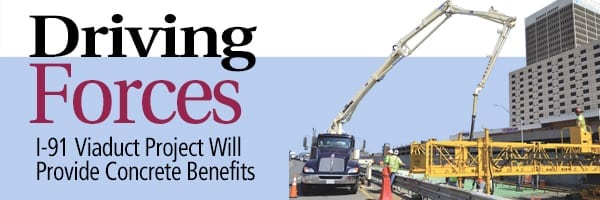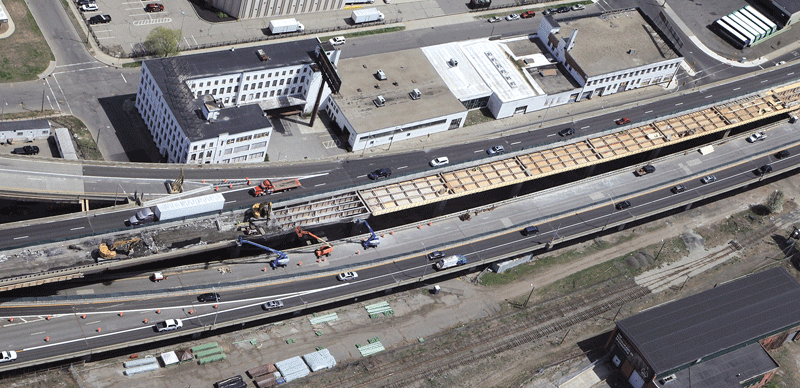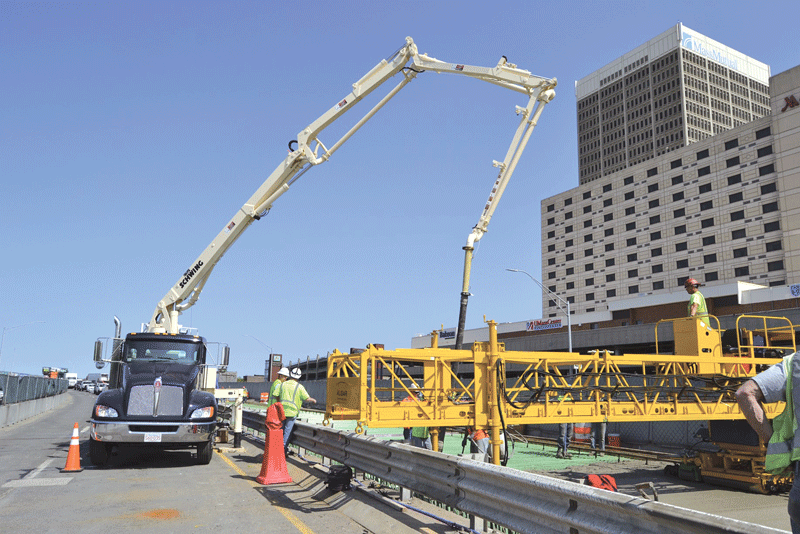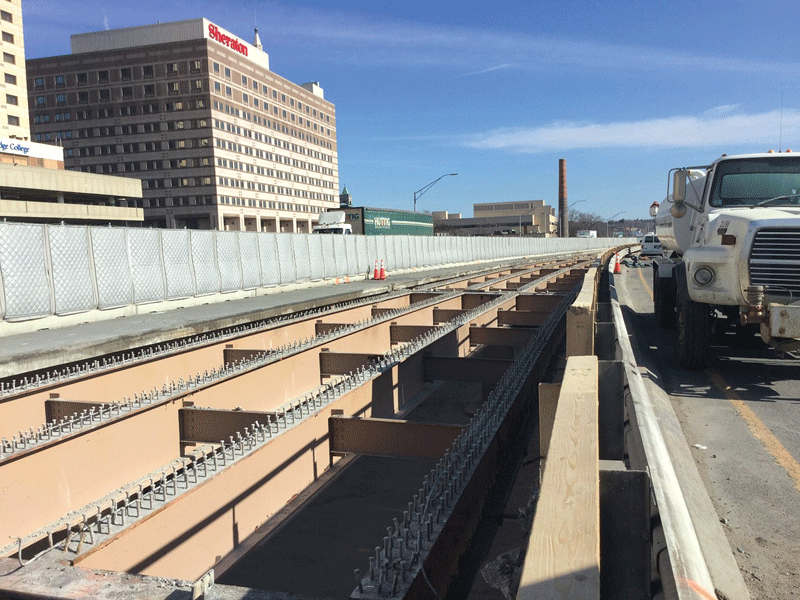
I-91 Viaduct Project Will Provide Concrete Benefits
Driving Forces

An overhead view of work on the inner lanes of I-91’s Springfield viaduct.
In May 2015, the Massachusetts Department of Transportation signed a $148 million contract with the Joint Venture of JF White-Schiavone to overhaul the 1-91 viaduct in Springfield. The project is immense in scope, and although it has inconvenienced drivers, especially during peak hours, it is ahead of schedule and brings concrete benefits for the local economy and area businesses that manufacture or provide products needed for the repair and reconstruction of the 45-year-old section of highway.
Richard Masse says that, when the state Department of Transportation (or MassDOT, as it’s called) developed plans for reconstructing the 1-91 viaduct that runs through Springfield, it was well aware of the impact and inconvenience the project would have on drivers traveling north and south.
Indeed, state officials felt that completing the $148 million project on time or ahead of schedule was so critical that they built an attractive bonus into the contract to keep work moving along as quickly as possible.
“We established an incentive of $50,000 a day for up to 180 days to finish earlier than the contract specified,” said Masse, district project development engineer for MassDOT Highway Division District 2.
This equates to a potential bonus of $9 million for the Joint Venture of JF White-Schiavone if specific conditions are met. And those conditions are clearly outlined: the entire project does not have to be complete, but the ‘full beneficial use’ milestone has to be met, which means work on all lanes and ramps must be finished, and they must be open and functioning, before Aug. 6, 2018. This constitutes the majority of the work.
Such incentives are rare, and this is the largest ever offered by District 2, but it is tempered by a disincentive: There will be a penalty of $50,000 for every day the contractor is late in meeting the milestone.
But that’s not likely to happen. In fact, JF White-Schiavone, benefiting from mostly benign weather (the recent storm was a definite exception), is three months ahead of schedule, and workers continue to labor around the clock to get the project done.
The roadway under reconstruction is only eight-tenths of a mile in length, but the work involves far more than simply removing the old decking on the six traffic lanes and repaving them. There are 96 separate spans of bridge between the south abutment on State Street and the north abutment near the I-291 exit, and each span is supported by a pier that needs to be repaired.

Officials say the viaduct project is proceeding ahead of schedule, thanks to relatively mild winters and some attractive incentives.
In fact, the $148 million contract holds enormous weight — literally and figuratively — and area businesses are benefiting due to the materials that are needed and will be used by the time the project is complete.
Specifically, crews will replace 44,000 tons of concrete with the new bridge deck and barriers, use 7.2 million pounds (3,600 tons) of steel reinforcement, install 134 drainage inlets on the bridge, erect 2.5 miles of snow fence on the barriers, and paint 28 acres, or 1.2 million square feet, of steel.
Concrete is being purchased from Construction Service in Wilbraham, asphalt paving comes from Lane Construction Corp. in Springfield, the 600-plus feet of noise-control curtains mounted in front of downtown hotels were purchased from Sound Seal in Agawam, and gravel and stone is being provided by Ginmar Enterprises in Ludlow.
In addition, Commonwealth Guardrail in Westfield is furnishing that product, all catch basins and manhole castings will be purchased from E.J. Prescott Inc. in West Springfield, and CJ’s Towing Unlimited Inc. in Springfield is part of the safety plan to remove vehicles involved in crashes as quickly as possible, which is important because traffic is already squeezed between the barriers on the viaduct.
The project has also had a positive effect on employment. The Federal Highway Administration has done studies on the impact of major undertakings and reports that every $1 billion in spending supports 13,000 jobs for a year. “Since this project will cost $148 million, that translates to more than 1,900 job years of employment that are either created or supported,” Masse said.
For this issue and its focus on construction, BusinessWest takes an indepth look at the I-91 project — what’s been completed, what’s still to come, and what the long-term benefits will be for Springfield and the region.
Route Geometry
Although some people think the $950 million MGM Springfield resort casino has affected work that is being done on the viaduct or the way the on and off ramps will be configured in the future, it’s not true and simply a coincidence that construction on both projects is taking place simultaneously.
“We identified the need for the viaduct project late in 2011 before expanded gaming was even signed into law, and the project was approved and initiated prior to any casino proposals,” said Masse.
The viaduct was constructed and opened in 1971, and no improvements were made to it other than a few limited repairs that took place between 1999 and the early 2000s. As a result, the decking deteriorated as millions of vehicles passed over it and chemicals, salt, and sand were used to combat ice and snow during frigid winter months.
“It had reached the point where emergency repairs of potholes were becoming routine. We had to go out on the road in the middle of commuter traffic without warning, and it became clear that it was time for a long-term fix,” Masse said.
MassDOT did its best to identify challenges that might occur as it developed a plan for the project. The agency determined it was critical to keep the public informed about what was happening on a daily basis, so the contract contained language that mandated hiring a public-relations firm for that purpose.
Regina Villa Associates in Boston was chosen, and the company issues frequent notices and updates about the work in progress to all local media outlines. There is also a project webpage (www.massdot.state.ma.us/i91viaductrehab/home.aspx) where people can sign up to get e-mail alerts about daily or weekly changes.
In addition, work on the project is discussed at biweekly meetings that include officials from MassDOT, the Springfield Department of Public Works, the Springfield Parking Authority (two of its main facilities are under the viaduct), and MGM Springfield.
Masse noted that the casino has initiated its own street closings and plans to install a detection system at the end of the exit 6 ramp to facilitate traffic flow and help prevent accidents; if traffic starts to back up toward the highway, the stoplight will change to allow vehicles to move off the ramp. Other work is also being done on streets around the casino, but that has no bearing on the 1-91 viaduct project.
However, MGM’s presence at the meetings is important. “It gives us an opportunity to coordinate work and exchange schedule updates,” Masse said. “Their cooperation has been an important part of the project and helped to limit disruption.”
Although some media outlets have reported that a number of drivers have avoided the viaduct and will continue to do so until the project is complete, Masse said everything possible is being done to reduce the impact on local businesses.
“We understand that our projects are generally an inconvenience, and we certainly appreciate that there can be some negative impact on local businesses. But we haven’t had any feedback of that nature,” he told BusinessWest, adding that business owners as well as the general public are invited to send comments, suggestions, or inquiries to MassDOT via the project website, and feedback has already resulted in things such as adjustments to signage.

Richard Masse says that, when it’s completed, the reconstructed viaduct will help make Springfield an attractive destination.
Another change that went live Feb. 1 was made in response to input from drivers who expressed concern about safety where lanes on I-91 South are reduced from two down to one.
The feedback led MassDOT to implement a pilot program for a ‘dynamic lane merge system,’ which is designed to make merging safer and alleviate congestion.
It’s the first time this system has been used in the Commonwealth, and it will help to ensure that vehicles familiar with the lane closure don’t bypass others and cause them to wait for a longer period of time than those who use the roadway on a frequent basis. The system works by using computer sensors to monitor traffic and letting drivers know what the best merge strategy is via electronic signage.
Paving the Way
The viaduct project has many goals, including replacement of the reinforced concrete bridge deck, painting of all structural steel, replacing the bridge bearings, improving bridge drainage and highway lighting on and under the structure, miscellaneous structural steel repairs, improving traffic signage on the structure, and other safety improvements in the immediate vicinity, such as installing new sprinkler systems and LED lighting on the upper levels of the 1-91 North and South parking garages, which are run by the Springfield Parking Authority in space leased from the state.
Masse said the project was divided into two main phases so half the decks could be replaced at a time. Last year, work was concentrated on the inside decks, and traffic was moved to the outside, and now that phase I is complete, the process has been reversed, and construction is taking place in the low-speed travel lane and shoulder portions of the viaduct, and on the I-91 northbound on-ramp to I-291 East.
The same ramps that were closed during phase I will remain closed, and the only change is that the exit 9 off-ramp from I-91 North to Route 20 West/Route 20A East will be closed until phase II is complete.
About 100 people show up to work at the site every day, and in addition to day and evening shifts, construction efforts often continue throughout the night. The noisy work of demolishing the existing decks is done during the day, and debris is carried away after dark.
“The crews use very large jackhammers mounted to excavating equipment to break up the deck,” Masse said, noting that saws are also used to cut portions of the material.
Workers recently began painting the steel girders, which is no small task — again, there are 1.2 million square feet of steel to repaint. But when the job is complete, it will help enhance the perception of that section of the highway.
“The beige paint that had reached the end of its useful life is being covered with a blue-green hue that will be much more attractive visually,” Masse said.
In addition to aesthetics, safety will be improved. “When we finish the deck replacement, the shoulder on the median side in the high-speed lane will be wider,” he continued, explaining that, in the past, there were two feet between the guardrail and the edge of the road, but a narrower concrete barrier will allow the inside shoulder to expand to four feet in width.
Other safety improvements include the construction of a barrier to stop I-291 traffic from shooting across several lanes on I-91 South to exit 7 at the Memorial Bridge.
When the project was in the development stage, Masse noted, input about this dangerous maneuver led MassDOT to make plans to install the new jersey barrier.
The number of drainage inlets will also be increased, which will reduce the amount of water that collects along the shoulder of the roadway.
Passing Thoughts
After the roadways are fully open, the remaining work will commence, and by the time the project is finished, the structural steel will be painted, municipal street lights will be installed, all final paving and traffic markings on local streets will be finished, temporary traffic signals will be replaced with permanent ones, and the temporary off-ramp from I-91 South to Birnie Avenue will be removed.
There is no doubt that the project is an inconvenience to drivers who have to schedule additional time to get to their destinations. But the benefits will be concrete: sales of products used in construction will help local companies to flourish, and drivers will have a safer and more appealing roadway to travel on between downtown Springfield and the Connecticut River.
“When everything is newly paved and painted and a modern lighting system is installed, the viaduct should help to make Springfield a more attractive destination,” Masse said. “When people see a highway that is well-cared-for, it will provide a welcoming gateway not only to Springfield, but to Western Mass.”






